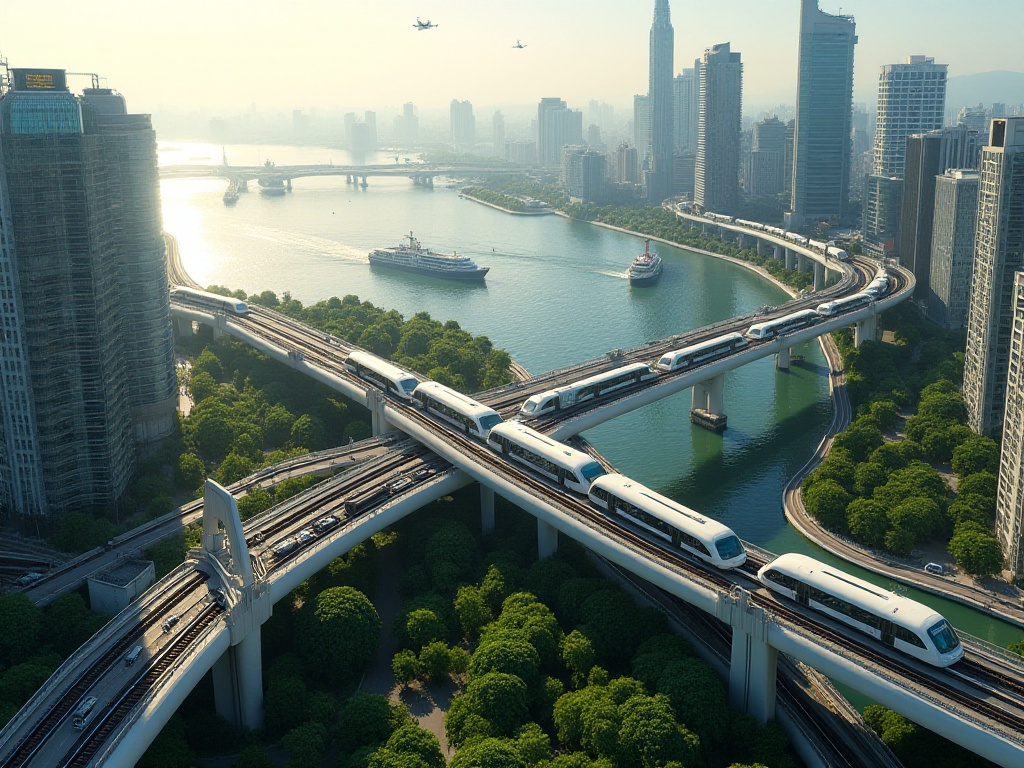The other day, I got lost again in the New York subway. Standing on the crowded platform, watching trains whizzing by, I found it somewhat amusing. As a girl from Beijing, even though I've lived in New York for almost a year, I still frequently get disoriented in this complex subway system. Sometimes I stand at intersections, looking up at signs marked with various numbers and letters, and my brain just freezes. However, honestly, each time I get lost leads me to discover new aspects of this city - a blessing in disguise, you could say.
When I first arrived in New York, just looking at the subway map gave me a headache. It wasn't so much a subway map as a plate of spaghetti. Different colored lines intertwined, with number and letter designations that made my head spin. Red 1/2/3 lines, blue A/C/E lines, orange B/D/F/M lines... these routes tangled together on the map like an unsolvable Rubik's cube.
Having lived in Beijing for over twenty years, I was used to the straightforward naming system of Line 1, Line 2, etc. Each line had its distinct color, clear routes, and obvious transfer stations. But here in New York? Just memorizing the colors and letters of each line is challenging enough, not to mention they change routes at different times. On weekends, some lines might temporarily reroute or suspend service - something almost unimaginable in Beijing's subway.
I remember the first time I saw the route map on the platform, I stood there studying it for a full half hour. The station names on the map looked like tiny ants crawling around. Union Square, Times Square, Grand Central... these names were both foreign and fascinating to me. I wondered how long it would take to memorize all these station names.

Let me tell you about my first subway adventure. That day, I needed to go from Upper Manhattan to Brooklyn to meet a friend. What should have been a simple trip turned into a nearly two-hour journey in the subway. This nerve-wracking journey was like a mini adventure film.
First, I mistakenly got on an Express train, which skipped several stations. When I realized what had happened, I was in a completely unfamiliar place. The feeling was terrible, like a non-swimmer being thrown into deep water. The platform signs seemed to be mocking me, and I even wondered if I had transported to a parallel universe.
Worse still, my phone was running low on battery, and Google Maps kept malfunctioning. The underground signal was intermittent, making me even more panicked. I remember standing on the platform, watching trains roar past, having no idea which one to take.
Finally, a kind elderly New Yorker helped me. He not only gave me detailed directions but also drew a simple map on paper. Honestly, I was deeply touched at that moment. In this fast-paced city, encountering such warmth is truly precious.
This experience taught me an important lesson: in New York, the difference between express and local trains is crucial. Express trains are faster but skip many stations. If you're unfamiliar with the route, it's better to take local trains - they're slower but at least you won't miss your stop.
Another time, I encountered even bigger trouble late at night. After attending a friend's party, I planned to take the subway home. At the station, I discovered that many lines had different routes during late hours. Familiar routes suddenly became unfamiliar, and the electronic displays kept scrolling various temporary adjustment notices.
I remember standing on the empty platform with just a few equally confused passengers around. Eventually, I had to take alternative lines and make a huge detour to get home. This experience taught me that in New York, subway route changes are common, and you must always be prepared for alternatives.
After many such lessons, I've compiled several useful tips. Did you know there's actually a lot of crucial information on New York subway platforms? Those black signs are like treasure maps - if you observe carefully, you can find the right direction to your destination.
For instance, the signs above the platform not only tell you whether it's an express or local platform but also indicate how the line operates during special hours. I wasted a lot of time waiting on platforms simply because I didn't pay attention to this information. Now, checking these signs is the first thing I do when entering a station.
Another important discovery is about transfers. In New York, many major transfer stations have multiple entrances and exits - choosing the right one can save a lot of time. For example, at Union Square station, if you want to transfer to the L line, you need to go to the southern end of the platform. These details I learned bit by bit through experience.
The subway station's signage system is actually quite user-friendly, it just takes time to get used to. Each platform uses different colors to mark different lines, and every platform column shows information about the next station. These details make riding the subway much easier once you're familiar with them.
I've also noticed an interesting phenomenon: different lines have different passenger demographics. For instance, the L line often carries many artistic young people because it runs through artsy areas like Williamsburg. The 7 line, being Queens' main artery, often has carriages filled with various languages.

Regarding subway tickets, I strongly recommend getting a Metro Card. It's not just about saving money - it affects your daily travel experience in New York. Let me break down the math for you.
A single ride costs $3, but with a Metro Card, it's $2.90. Seems like a small difference, right? But if you load $50 or more, the subway company gives you an extra 10%. This brings the actual cost per ride down to about $2.60. If you ride frequently, these savings could buy you several lunches.
The Metro Card has another little-known benefit: free bus transfers within 125 minutes. This means you can freely switch between subway and bus using the same card without additional charges. This is especially useful in areas where subway access is limited.
Choosing the right amount to load is also strategic. I usually load $116 because this gives the maximum bonus amount. Loading too little doesn't earn much bonus, while loading too much risks loss if the card goes missing. Speaking of lost cards, here's a tip: always register your Metro Card on the official website. This way, you can transfer the balance to a new card if yours is lost.
Another money-saving tip concerns monthly passes. If you commute daily by subway, a monthly pass might be more economical. At $127, it becomes cheaper than individual rides if you take the subway more than 46 times per month. Note that the 30-day period starts from first use, not by calendar month.

Regarding safety, this is no joking matter. As a woman, I'm particularly sensitive to safety issues. When riding the subway at night, I deliberately choose cars with other passengers. This isn't being overcautious - it's necessary precaution.
According to MTA statistics, over 60% of subway crimes in 2023 occurred in sparsely populated cars. When choosing a car, I usually observe the passenger distribution. If I see an unusually empty car, I avoid it.
Besides choosing the right car, positioning is important. I habitually stand near the doors where I can observe my surroundings. During late hours, I try to stay in cars closer to the conductor's booth. These simple details can greatly improve safety.
Emergency help buttons in subway stations are important to remember. Each platform has these red buttons for immediate assistance in emergencies. However, note that these aren't for asking directions - misuse can result in fines.
I've noticed many New Yorkers wear headphones to listen to music, but this reduces alertness. Even when I wear headphones, I keep the volume low to maintain awareness of my surroundings.
While waiting for trains, I stay away from platform edges. New York subway trains move fast and create strong air currents. Standing too close is not only dangerous but can be startling. It's best to stand behind the yellow line for both safety and smooth boarding.
In New York, the subway is our lifeline. Imagine - over 5 million subway rides daily, exceeding many cities' populations. Behind these massive numbers are countless New Yorkers' daily lives.
To survive in this complex system, first learn to recognize various signs. For instance, if you're heading the wrong direction, don't panic - find the "Free Crossover" sign, which means you can transfer to the opposite direction without additional charge. This tip has saved me unnecessary expenses.
Rush hour survival skills are crucial. 7-9 AM and 5-7 PM are the busiest times. Pay special attention to train intervals during these times. I usually use phone apps to check real-time arrival information for better time management.
In crowded cars, learn to use space efficiently. While positions near doors are convenient, they're constantly disturbed by entering and exiting passengers. For longer trips, it's better to move toward the middle of the car where it's usually less crowded.
Another important survival rule is learning to read station maps. Each platform has detailed route maps, and many major stations have electronic displays showing real-time train locations. This information helps better plan your route.
Don't panic during delays. Though New York's subway is historic, the system is relatively reliable. During serious delays, station staff usually announce alternative routes. Listen carefully to announcements and ask station staff if necessary.

On the subway, you never know what interesting things you'll encounter. Once while waiting for a train, I saw a group of street performers in the car. Their performance was quite professional and eye-opening.
In New York, over 200 performer groups perform daily in the subway system, and they must pass official MTA auditions to perform. These artists have designated performance areas and time slots - something I never expected.
Sometimes on platforms, you can see interesting art installations. Many subway stations have unique artworks reflecting local history and culture. For example, Union Square station has mosaic murals depicting labor movement history.
I've experienced some particularly heartwarming moments. Once during heavy rain, a stranger seeing me without an umbrella shared theirs with me. Such moments of kindness are especially precious in New York's fast-paced environment.
Vendors in the subway are also a unique sight. Though selling is prohibited, you often see people secretly selling snacks and drinks. However, I advise against buying anything in the subway as it might cause trouble.

Looking back on this year's subway experiences, while there were times of confusion and anxiety, there was more understanding and love for this city. Each time getting lost led to a deeper understanding of New York.
The city's subway system is like a huge maze hiding countless stories and surprises. It not only connects different parts of the city but also connects various people and their stories. From early morning commuters to late-night returners, everyone writes their own story in this system.
Now, I can navigate different subway lines skillfully. Though I still get lost occasionally, these moments feel familiar now. Because in New York, getting lost is another way of exploring.
Each time I enter a subway station, I think of myself when I first arrived in New York. Then, I was full of curiosity and uncertainty, but now, these once-troubling experiences have become precious memories. This is probably what growing up means - gradually finding your own way through constant exploration and trial.
 Previous
Previous
